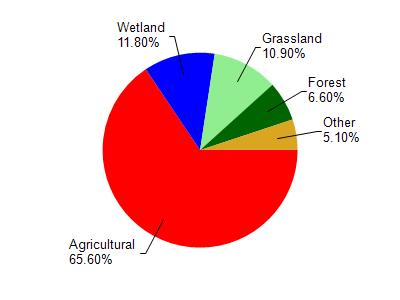Dane
No
No
No
Fish and Aquatic Life
Overview
Schumacher Creek, in the Maunesha River Watershed, is a 3.49 mile river that falls in Dane County. This river is managed for fishing and swimming and is currently not considered impaired.
Date 2011
Author Aquatic Biologist
Historical Description
Schumacher Creek -T8N, RI2E, Sec. 9, Surface acres = 1.5, Length = 3 miles, Stream order = I, Gradient = 5 ft/mile, Base discharge = 0.1 cfs.
Schumacher Creek is a small tributary to the Maunesha River that originates in Section 30 of Medina Township and empties into the Marshall Millpond. Its gradient and base flow are quite low. The creek drains eleven square miles of cropland and wetlands. It is extensively ditched upstream to keep the croplands drained. Wetlands occur near the creek's mouth (Dane Cty. Reg. Plann. Comm. 1979a) and the substrate consists of peat and silt. The waters of Schumacher Creek are slightly high in dissolved solids, probably resulting from erosion as there are no known point sources of pollution entering the creek. The fishery is very limited, consisting only of seasonal use by forage species. Access is available at Hwy. T and through the millpond. Fish species: forage species.
From: Day, Elizabeth A.; Grzebieniak, Gayle P.; Osterby, Kurt M.; and Brynildson, Clifford L., 1985. Lake and Stream Classification Project. Surface Water Resources of Dane County, Wisconsin Department of Natural Resources, Madison, WI.
Date 1985
Author Surface Water Inventory Of Wisconsin
Condition
Wisconsin has over 84,000 miles of streams, 15,000 lakes and milllions of acres of wetlands. Assessing the condition of this vast amount of water is challenging. The state's water monitoring program uses a media-based, cross-program approach to analyze water condition. An updated monitoring strategy (2015-2020) is now available. Compliance with Clean Water Act fishable, swimmable standards are located in the Executive Summary of Water Condition in 2018. See also the 'monitoring and projects' tab.
Management Goals
Wisconsin's Water Quality Standards provide qualitative and quantitative goals for waters that are protective of Fishable, Swimmable conditions [Learn more]. Waters that do not meet water quality standards are considered impaired and restoration actions are planned and carried out until the water is once again fishable and swimmable
Management goals can include creation or implementation of a Total Maximum Daily Load analysis, a Nine Key Element Plan, or other restoration work, education and outreach and more. If specific recommendations exist for this water, they will be displayed below online.
Monitoring
Monitoring the condition of a river, stream, or lake includes gathering physical, chemical, biological, and habitat data. Comprehensive studies often gather all these parameters in great detail, while lighter assessment events will involve sampling physical, chemical and biological data such as macroinvertebrates. Aquatic macroinvertebrates and fish communities integrate watershed or catchment condition, providing great insight into overall ecosystem health. Chemical and habitat parameters tell researchers more about human induced problems including contaminated runoff, point source dischargers, or habitat issues that foster or limit the potential of aquatic communities to thrive in a given area. Wisconsin's Water Monitoring Strategy was recenty updated.
Grants and Management Projects
| Project Name (Click for Details) | Year Started |
|---|
|
|
Monitoring Projects
| WBIC | Official Waterbody Name | Station ID | Station Name | Earliest Fieldwork Date | Latest Fieldwork Date | View Station | View Data |
|---|
| 839200 | Schumacher Creek | 10020959 | Schumacher Cr. Cth T | | | Map | Data |
|

Watershed Characteristics
Schumacher Creek is located in the Maunesha River watershed which is 126.02 mi². Land use in the watershed is primarily agricultural (65.60%), wetland (11.80%) and a mix of grassland (10.90%) and other uses (11.70%). This watershed has 214.16 stream miles, 73.72 lake acres and 9,637.67 wetland acres.
Nonpoint Source Characteristics
This watershed is ranked Low for runoff impacts on streams, Low for runoff impacts on lakes and High for runoff impacts on groundwater and therefore has an overall rank of High. This value can be used in ranking the watershed or individual waterbodies for grant funding under state and county programs.However, all waters are affected by diffuse pollutant sources regardless of initial water quality. Applications for specific runoff projects under state or county grant programs may be pursued. For more information, go to surface water program grants.